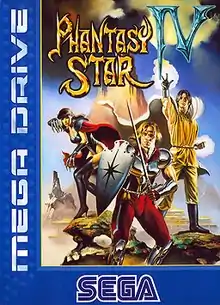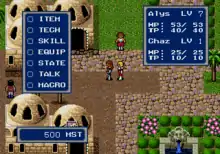Phantasy Star IV
Phantasy Star: The End of the Millennium[1] is a science fantasy role-playing video game developed and published by Sega. It was released for the Sega Genesis in Japan in 1993 and Europe and North America in 1995. It is the fourth and final game in the original Phantasy Star series, concluding the story of the Algol Star System. Phantasy Star IV kept many of the gameplay elements of the previous game, including turn-based battles, overhead exploration, and magic spells. It received mixed reviews upon its release, but has been subject to more positive retrospectives. The game was also released for the Wii Virtual Console in 2008, and has also been included in various Sega emulated collections.
| Phantasy Star IV | |
|---|---|
 Cover art for the European release, with art done by Boris Vallejo | |
| Developer(s) | Sega |
| Publisher(s) | Sega |
| Director(s) | Rieko Kodama Toru Yoshida Kiyoshi Takeuchi |
| Producer(s) | Jerry Markota |
| Artist(s) | Toru Yoshida |
| Writer(s) | Akinori Nishiyama Toru Yoshida |
| Composer(s) | Izuho Numata Masaki Nakagaki |
| Series | Phantasy Star |
| Platform(s) | Sega Genesis |
| Release | |
| Genre(s) | Role-playing video game |
| Mode(s) | Single-player |
Gameplay
Phantasy Star IV is an archetypal role-playing video game, featuring the staples of exploration, NPC interaction, and turn-based combat. Like the previous games in the Phantasy Star series, individual characters each have their own statistics and equipment that determine the character's performance in combat, improving their statistics by gaining experience levels (achieved through victory in combat). Additionally, non-android characters have access to "Techniques," i.e. magic spells, the use of which draw upon a character's pool of "Technique Points" (TP), with new techniques being learned as a character gains levels.
Phantasy Star IV has a number of features new to the series, including combination techniques, manga-style panel illustrations that accompany the narrative, and an expanded script.[2]
The instruction manual for the American version states that there are 15 possible combination attacks. However, only 14 were ever discovered.[3][4][5] Occasionally, the "secret technique" Feeve, a useless technique accessible through hacking, is mistaken for the "lost 15th combo."[6]
Plot

Phantasy Star IV takes place 1,000 years after the events of Phantasy Star II and 1,000 years before the era of Phantasy Star III. After an event called the Great Collapse, much of the once-thriving planet Motavia has reverted back to a desert, and life has become progressively more difficult for the planet's inhabitants. To make matters worse, there has been a marked increase in the numbers of the "biomonsters," a catch-all term for the strange and violent aberrations of Motavia's flora and fauna.
Keeping these creatures under control is the job of "hunters". During an investigation into such an outbreak, Chaz Ashley, a young hunter, learns of the relationship between the biomonster problem and the planet's ecological crisis. The planet is in the process of returning to its original desert state as the climate and biosphere-controlling devices installed over a thousand years previous begin to fail. The reasons behind the malfunctions are clarified as the plot unfolds, relating directly to the events of Phantasy Star II.
Chaz and his allies connect the world's troubles to a cult leader called Zio, "The Black Magician," whose aims appear to be total annihilation, not only of Motavia, but of the whole Algol solar system. The heroes stop Zio in order to restore the computer systems maintaining Motavia. However, it soon becomes clear that Zio is merely the vanguard to a much larger enemy, long buried in the past. The secrets of the Algol star system are revealed as Chaz and company discover both the nature of the threat to their worlds as well as the safeguards placed in a time long forgotten.
Release
The game was released in Japan in December 1993, North America in February 1995 and the United Kingdom and Europe in December, 1995.[7] End of the Millennium was the first Phantasy Star title not to be localized to Brazil by Tec Toy. Sega initially stated that they would not publish the game in Europe.[8]
In the United States, the game retailed for just under $100.[9]
The cover art for the American and European releases was done by Boris Vallejo. Both covers depict Chaz, Rika, and Rune, but the American/European box art deviates from their appearance in-game.
In Japan, the game was initially announced as Phantasy Star IV,[10] but by the time of release it had been renamed Phantasy Star: The End of the Millennium. At the time, this renaming was seen by the gaming press as an attempt to make it clear that the game was a followup to Phantasy Star II.[11] The American and European releases took the title Phantasy Star IV, though the title screen of all versions of the game reads Phantasy Star: The End of the Millennium. The titles are combined to Phantasy Star IV: The End of the Millennium in the Sega Genesis Collection compilation.
Phantasy Star IV was the last Phantasy Star game until Phantasy Star Online (2000), which has a mainly unrelated story.[12]
Ports and remakes
The game was ported as part of Phantasy Star Collection for the Sega Saturn, released only in Japan. There was a Windows port released in 2004, as well as its inclusion in the Sega Genesis Collection, Sonic's Ultimate Genesis Collection, Sega Genesis Classics, and the Sega Genesis Mini. Sega Ages planned a remake for the PlayStation 2 console,[13] having revamped the first two games: Phantasy Star Generation 1 and Phantasy Star Generation 2.
Reception
| Aggregator | Score |
|---|---|
| GameRankings | 87%[14] |
| Publication | Score |
|---|---|
| EGM | 7.75/10[9] |
| Eurogamer | 8/10[15] |
| GameFan | 190/200[16] |
| IGN | 9/10[17] |
| Mean Machines Sega | 88%[8] |
| Next Generation | |
| Nintendo Life | |
| RPGamer | 9/10[20] |
| RPGFan | 90%[21] |
| Sega Power | 87%[22] |
| Sega Pro | 95%[23] |
| Sega Saturn Magazine | 90%[24] |
Phantasy Star IV: End of the Millennium received generally positive reviews, with critics typically approving of the gameplay elements but disapproving of the story and graphics. GamePro praised the ability to inspect background objects, the convenience of the macros and talk option, and the translation. However, they commented that the inability to purchase multiple items at once is irritating, and were especially critical of the story, describing it as routine, frequently incoherent, and derogatory towards women.[25] Next Generation remarked that Phantasy Star IV, "while still a good game, is years behind." They elaborated that while other RPGs were making major innovations to the genre in both graphics and gameplay, Phantasy Star IV still fundamentally looked and played the same as Phantasy Star II from five years before.[18] The four reviewers of Electronic Gaming Monthly commented that the graphics are mediocre, the music is irritating, and the story is too slow-paced, but that the magic/technique system, equipment, and general gameplay are all highly involving and enjoyable.[9] Sega Saturn Magazine (previously Sega Magazine) said that the graphics are outdated even compared to other Mega Drive/Genesis games and that the game is incomprehensible to newcomers to the series, but that "the game succeeds by creating cinematic moments, introducing new characters and powers, and taking many weird and wonderful plot turns."[24] Mean Machines criticized the graphics, animation, and effects, but praised the playability, story, and lastability, calling it the "best pure RPG for the Megadrive."[8] GameFan criticized the translation, but said the "graphics are beautiful, the music is powerful, and the non-stop original ideas make this cartridge an absolute must-own for the RPG enthusiast".[16]
Retrospective reviews have been very positive. In RPGamer, Sepherstein praised the title as one of the greatest RPGs he'd ever played, with "magnificent graphics, sensational soundtrack, gripping story and incredible battle system".[20] Parn of RPGFan also called it one of "the best RPGs ever made".[21] Reviews for the Virtual Console release were also very positive. Nintendo Life's Corbie Dillard said that one couldn't have asked for a better end to the 16-bit series.[19] IGN called it one of the definitive 16-bit role-playing games, stating the "storyline and characters are deep and engaging," the "attractive anime-style cutscenes steal the show visually," and the gameplay is both "classic and unique at the same time."[17] Tor.com described it as "an ambitious JRPG that is the perfect end to the series, taking the best elements of each of the previous games and weaving together a 'phantastic' journey."[26] Eurogamer stated that it is "epic in scope" and recommended that "anyone with a fondness for JRPGs should investigate this at once."[15]
In 2007, IGN ranked Phantasy Star IV as the 61st best game ever made.[27] In 2012, IGN placed Phantasy Star IV at number 59 in their Top 100 RPGs of all time, citing the elegantly simple mechanics and the game's influence on Phantasy Star Online (which they ranked as number 23 on the list).[28] In 2009 Nintendo Power labelled the title, along with Phantasy Star II, as one of the greatest RPGs of all time.[29] Complex Magazine ranked the game number 2, behind only Gunstar Heroes, in its list of the best Sega Genesis games.[30]
References
- ファンタシースター 千年紀の終りに, Fantashī Sutā Sennenki no Owari Ni
- Tieryas, Peter. "The Amazing Legacy of Phantasy Star IV's Fallen Utopia". Kotaku. Retrieved 2021-01-31.
- "RPGClassics.com - Phantasy Star IV". Shrines.rpgclassics.com. Retrieved 2011-03-10.
- "Phantasy Star IV Combination Attacks". Phantasy-star.net. Retrieved 2011-03-10.
- "Phantasy Star IV (GEN) FAQ/Walkthrough by Sir Pobalot". GameFAQs. 2004-08-23. Retrieved 2011-03-10.
- "The Secret Technique • Phantasy Star: Fringes of Algo". Psalgo.com. Retrieved 2011-03-10.
- "Phantasy Star IV Release Information for Genesis". GameFAQs. Retrieved 2011-03-10.
- "Megadrive Review: Phantasy Star IV". Mean Machines Sega. No. 33. July 1995. pp. 76–77. Retrieved 16 November 2017.
- "Phantasy Star IV: End of the Millennium Review". Electronic Gaming Monthly. Ziff Davis (69): 35. April 1995.
- "The Phantasy Star Compendium Translation". Archived from the original on February 10, 2008. Retrieved January 12, 2008.
- "International Outlook". Electronic Gaming Monthly. Ziff Davis (53): 94. December 1993.
- Stahl, Ben (May 17, 2006). "Phantasy Star Online Hands-On". GameSpot. Archived from the original on June 12, 2018.
- "Sega Ages Line Up Page". Ages.sega.jp. Retrieved 2011-03-10.
- "Phantasy Star IV for Genesis". GameRankings. Archived from the original on 2019-12-09. Retrieved 2021-01-23.
- Whitehead, Dan (November 17, 2008). "Virtual Console Roundup". Eurogamer.net. Retrieved 15 November 2017.
- GameFan, Volume 3, Issue 4, April 1995
- Thomas, Lucas M. (2 January 2009). "Phantasy Star IV: The End of the Millennium Review".
- "Downhill". Next Generation. Imagine Media (3): 95. March 1995.
- Dillard, Corbie (November 14, 2008). "Review: Phantasy Star IV". Nintendo Life. Retrieved 15 November 2017.
- "Phantasy Star IV - Review". RPGamer. Archived from the original on 1 September 2017. Retrieved 15 November 2017.
- "RPGFan Reviews - Phantasy Star IV". www.rpgfan.com.
- Sega Power, Issue 73, page 51
- Sega Pro, Issue 44, pages 40-41
- "Review: Phantasy Star IV". Sega Saturn Magazine. Emap International Limited (2): 91. December 1995.
- "Role-Player's Realm: Phantasy Star: End of the Millennium". GamePro. IDG (77): 116–117. February 1995.
- "Archived copy". Archived from the original on 2017-06-18. Retrieved 2017-06-09.CS1 maint: archived copy as title (link) Tor.com
- "Archived copy". Archived from the original on 2008-10-30. Retrieved 2016-08-05.CS1 maint: archived copy as title (link)
- "#59: Phantasy Star IV". IGN. 2012. Retrieved 29 November 2014.
- Editors of Nintendo Power: Nintendo Power February 2009: Issue 2 (in English). Future US Inc, 39-42. Retrieved February 1, 2010.
- "The 100 Best Sega Genesis Games". Complex. Retrieved 2021-02-01.